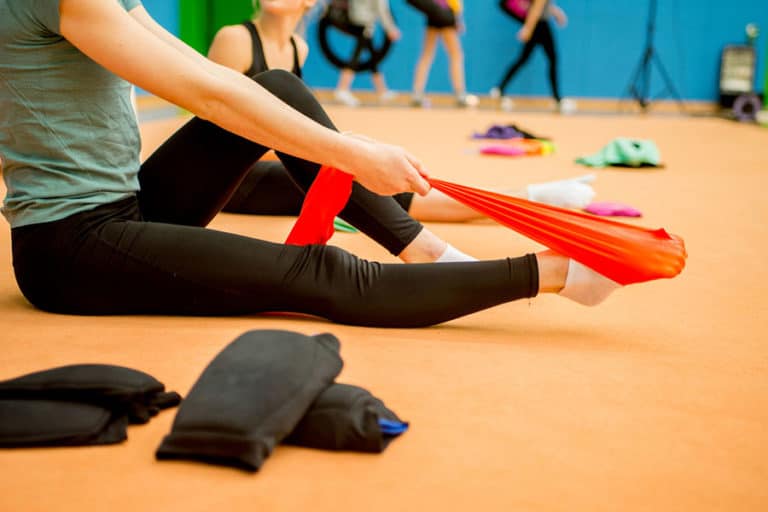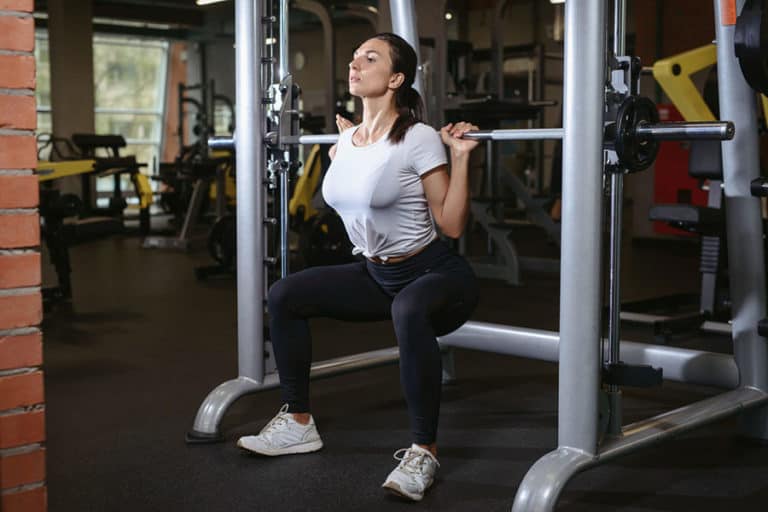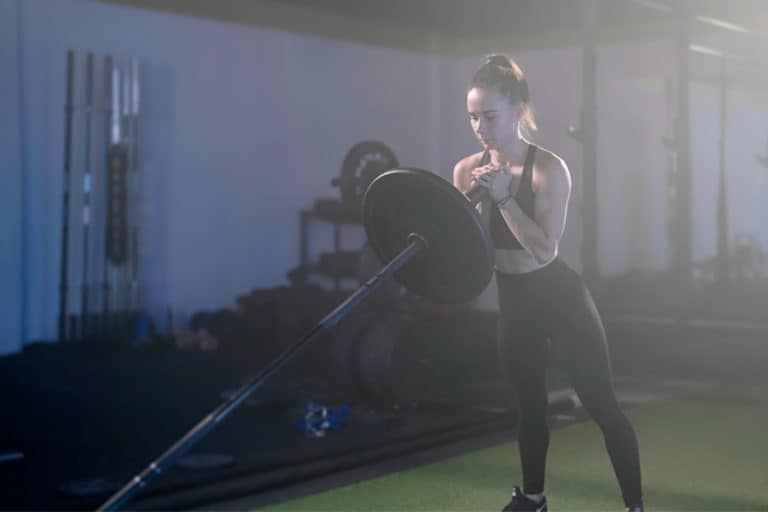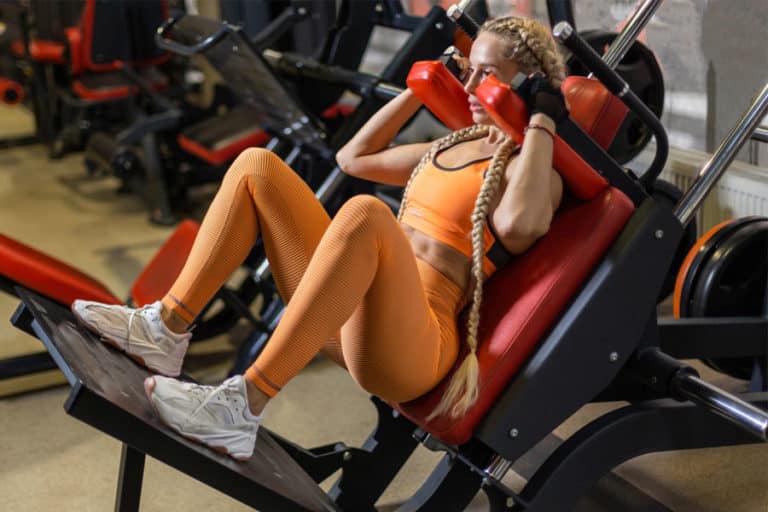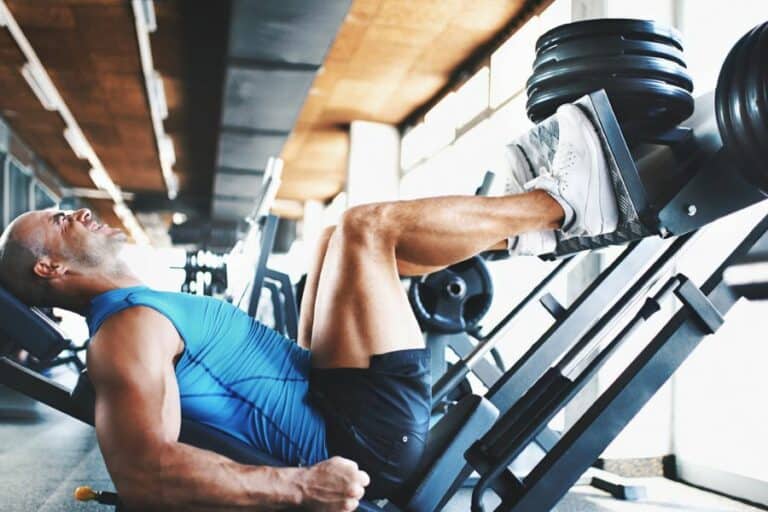Overhead Squat – How To Do, Benefits And Safety Measures

How to do | Muscles Worked | Who should/should not | Add to routine | Safety Tips | Benefits | Variations
Overhead squats are a powerful lower body workout. They are a prerequisite for most of the advanced strength training programs, especially for the Olympic lift “Snatch.” Popularized by CrossFit, it has managed to make its place in all levels of fitness regimes as a powerful mobility tool.
How to do an overhead squat?
To perform a barbell overhead squat, it is mandatory to grasp its proper form and technique thoroughly.
Equipment: Barbell (You may add plates as per your capacity)
The initial positioning
- Begin by standing with an upright torso and your chest high.
- Keep your feet shoulder-width apart and toes slightly pointing outwards.
- Take the barbell off the rack and place it across your shoulder as you do for a back squat.
- Position your grip on the barbell slightly wider than your shoulders, more towards the plates (if loaded). Ensure your elbows are pointing to the floor.
- Rotate the shoulders outwards to engage your lats and keep your chin tucked in.
- Keep your spine in a neutral position and engage your core.
- Do not let your hips slide forward.
The overhead push
- Now inhale, bend your knees slightly, and drop your hips a few inches lower.
- Exhale and extend your knees and hips while pushing the barbell explosively over your head (push through your legs and shoulders).
- Lock your elbows once you have the bar overhead. Create a stable upper back position.
The decent
- Inhale and start lowering your hips, bending your knees into a squat, and going as low as possible.
- Keep your core engaged and your elbows are fully extended through the entire movement.
- Ensure your knees are in line with your feet.
- Control the weight through the full range of motion of the squat.
- Hold the pose at the bottom of the squat.
The drive up
- Now exhale and steadily begin the upward movement by driving up through your feet and standing erect.
- Ensure your chest and hips rise at the same rate, and your hips and knees are fully extended.
- Continue with the advised number of sets and carefully place the barbell back on your shoulders, then place it back on the rack.
Muscles worked
Squats are compound exercises [1]American Council on Exercise: 5 Benefits of Compound Exercises that work several muscles simultaneously. Overhead squats are an intensely challenging, weighted variation of the traditional squats. As such, they target a lot of muscles in the posterior chain. Given below are the particular muscle groups it targets:
Primary muscles
| Quadriceps | rectus femoris, vastus lateralis, vastus medialis, vastus intermedius |
Secondary muscles
| Core | transversus abdominis, rectus abdominis, external oblique muscles |
| Calves | gastrocnemius and the soleus |
| Hamstrings | semitendinosus, semimembranosus, and biceps femoris |
| Lower back | multifidus, erector spinae, spinalis, latissimus dorsi |
| Shoulders | deltoids and trapezius |
| Upper arm | triceps |
| Upper back | rhomboids, latissimus dorsi, erector spinae, multifidus, and quadratus lumborum |
| Inner thigh muscles | hip adductors |
| Glutes | gluteus maximus, gluteus medius, and Gluteus minimus |
Who should and should not do overhead squats?
As overhead squats are an advanced exercise, they impose certain challenges. However, at the same time, they are loaded with benefits. Thus, it is critical to understand if you should or should not include this exercise in your workout routine.
Here are some specific categories of people who must or mustn’t do the exercise.
Who should
- Professional/Olympic weightlifters working on snatch must include overhead squats in their routine. Overhead squats build a strong foundation in establishing stability at the bottom of the squat. Thus, this helps in improving the snatch-receiving position.
- Strength/fitness athletes wanting to increase their shoulder mobility, stability, and strength should include overhead squats in their routine. Moreover, it is also a useful tool to simultaneously improve ankle, knee, and hip mobility and muscle mass. It is also helpful to advance to other explosive exercises.
- General fitness enthusiasts who are interested in strengthening their core and upper back. Adding on this movement can work as an assessment to spot imbalances, correct the squat form and improve the midline control.
Who shouldn’t
- In the initial stage of their fitness journey, beginners should not instantly jump onto an advanced exercise like the overhead squat. It is always advised to progress slowly to avoid injury.
- Anyone with prior injuries, medical conditions, and structural imbalances/ deformities like knee valgus should preferably avoid this exercise. If you still need to perform overhead squat, perform it under the supervision of a healthcare practitioner or a certified fitness instructor.
Adding it to your routine
You can add the overhead squat to your exercise program as per your fitness goal. Here’s how:
As a beginner
You may use an empty PVC pipe or a broomstick to do 2-4 sets of 2-5 reps with a resting time of 2-3 mins amidst sets.
This will allow you to understand the right squat positioning, wrist, elbow, ankle alignment, and barbell placement.
For strength training
Individuals undertaking strength training may perform fewer reps with more sets, 3-6 sets of 2-4 reps with a resting time of 2-3 mins amidst sets.
For muscle growth
The amount of time you spend under tension (TUT) [2]National Library of Medicine: Muscle time under tension during resistance exercise stimulates differential muscle protein sub-fractional synthetic responses in men increases your muscle growth (hypertrophy). Therefore, weightlifters interested in bulked-up muscles can perform 3-6 sets of 8-10 reps with a resting time of 1-2 mins between sets.
For increased endurance
Anyone interested in enhancing their endurance for performing athletic sports would need to perform higher reps with shorter rest [3]National Academy of Sports Medicine: DETERMINING THE BEST REST PERIODS BETWEEN SETS DURING TRAINING periods.
2-3 sets of 10-15 reps with an interval of 50-90 seconds amidst sets.
An overhead squats sample circuit
| Exercise | Reps | Sets |
| Sumo squat | 12 | 2 |
| Psitol squat | 10 | 2 |
| Back squat | 5 | 3 |
| Overhead squat | 5 | 2 |
Note: You may modify the choice of exercises, sets, and weights as per your capacity to adjust to your physical fitness and goals.
Safety measures to follow
As a note of caution, here are some safety tips that you must consider before performing the overhead squat:
- Warm-up and cool-down: Warm up with some dynamic stretches before attempting the overhead squat. This will help to reduce the risk of injury. Static stretches [4]Hospital for Special Surgery: Static vs. Dynamic Stretching: What Are They and Which Should You Do? work well for cooling down. Hence perform a few cool-down stretches for better flexibility and to reduce the risk of injury.
- Avoid ego lifting: Use a weight you can control in order to avoid accidents. Stop if you feel a lack of balance or pain.
- Maintain the proper form and technique: Maintain good form throughout the exercise to avoid strain on your body. Use a mirror to check your posture and breathing. It helps to spot common mistakes like unstable shoulders and core or incomplete range of motion.
- Progress steadily: Take your time to progress with this exercise. Do not increase the weight or duration too quickly, as this may lead to injury.
- Listen to your body: Overhead squats put a lot of pressure on the knees. If you have any knee injuries or pain, avoid this exercise. If you experience discomfort during the exercise, stop immediately and seek medical help.
- Take professional guidance: Use a spotter when lifting weights to avoid accidents. A spotter will guide you through the exercise and help you with the weights. This will help you avoid any accidents.
- Get rest: Rest adequately before training the same muscle groups. 24-48 hours of rest is considered sufficient for muscle recovery.
Benefits of doing overhead squats
Overhead squats provide an excellent workout to the entire body. Mentioned below is a list of benefits that overhead squats offer in significant ways:
- Overhead squats have an exceptional ability to assess errors and weaknesses [5]National Academy of Sports Medicine: Overhead Squat Solutions Table • CES in squat form. Regular practice of overhead squats can improve your squat form and technique.
- They are particularly known for providing stability, mobility, and balance.
- Overhead squats work on your overall strength and help you advance to other explosive and weighted lifts.
- Overhead squats are also recognized as a core-strengthening exercise for those with weak core muscles.
Variations to try
Overhead squats are a versatile exercise format and can be modified easily as per your level of fitness and preference.
Here are some squat variations for you to make your workout even more interesting:
Dumbbell overhead squats
The dumbbell overhead squats are a unilateral exercise for the upper body as well as the lower body. It requires you to lift a dumbbell in one hand and drive it overhead as you squat.
The form and technique guidelines remain the same as you do for barbell overhead squats.
Overhead lunges
This exercise can particularly benefit people who can not perform the required squat depth.
Moreover, performing walking lunges with weights overhead helps develop core muscles and improve overhead stability.
Pause overhead squats
As the name suggests, this variation of the overhead squats requires you to pause for a few seconds at the bottom of the squat. Pausing with weights overhead helps to increase control and improves balance. Moreover, it is also useful to enhance concentric strength due to the power required to get out of the squat.
Conclusion
To summarize, overhead squats are a great way to improve mobility and flexibility and to strengthen your muscles. They can be challenging at first, but with practice, you will see great results. Ensure to follow the safety measure before you start performing overhead squats to avoid injuries.
References
| ↑1 | American Council on Exercise: 5 Benefits of Compound Exercises |
|---|---|
| ↑2 | National Library of Medicine: Muscle time under tension during resistance exercise stimulates differential muscle protein sub-fractional synthetic responses in men |
| ↑3 | National Academy of Sports Medicine: DETERMINING THE BEST REST PERIODS BETWEEN SETS DURING TRAINING |
| ↑4 | Hospital for Special Surgery: Static vs. Dynamic Stretching: What Are They and Which Should You Do? |
| ↑5 | National Academy of Sports Medicine: Overhead Squat Solutions Table • CES |


